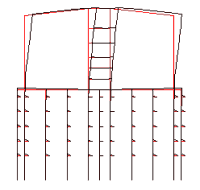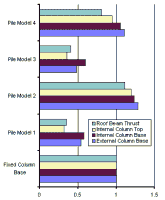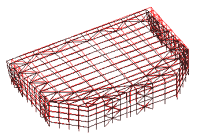Case Study
Seismic Eurocode Evaluated with LUSAS
UK Consulting Engineers Scott Wilson Kirkpatrick have been involved with
the earthquake resistant design code Eurocode 8 (EC8) since its inception and
used LUSAS Civil & Structural on two projects in Southern Asia to
evaluate initial amendments to the code.
In conducting the UK's National Assessment of the 1988 draft of the
code, design comparisons of buildings in steel, reinforced concrete, composite
construction and masonry were made using EC8 and American UBC/SEAOC design codes. Analysis
using the draft EC8 code was found to penalise irregular structures so more recent
editions have proposed a different approach involving a blanket reduction of the
structural performance factor 'q'. This until now has escaped a detailed investigation in
the UK. By virtue of their function many industrial structures have irregular arrangements
and a submarine hangar and a Boeing 747 hangar have been examined using LUSAS to
investigate the present design approach in EC8.
 The submarine hangar was used to
investigate seismic effects on a structure having irregularity due to its core and
foundations. Foundation irregularity can occur where a structure is supported by piles on
soil strata that varies across a site and where the foundation mass contributes to a high
proportion of the total mass of the structure. The hangar was built upon a piled raft
foundation and consisted of refit bays either side of a central reinforced concrete
multi-storey frame. External reinforced concrete columns were connected to the core with
steel beams cast into the column tops in such a way as to give fully dissipative
connections. In the design model the vertical spacing of cross-members in both transverse
and longitudinal frames were adjusted so that moments and flexural resistances could be
matched to give a degree of distributed inelasticity - the main goal of earthquake
resistant designs. The submarine hangar was used to
investigate seismic effects on a structure having irregularity due to its core and
foundations. Foundation irregularity can occur where a structure is supported by piles on
soil strata that varies across a site and where the foundation mass contributes to a high
proportion of the total mass of the structure. The hangar was built upon a piled raft
foundation and consisted of refit bays either side of a central reinforced concrete
multi-storey frame. External reinforced concrete columns were connected to the core with
steel beams cast into the column tops in such a way as to give fully dissipative
connections. In the design model the vertical spacing of cross-members in both transverse
and longitudinal frames were adjusted so that moments and flexural resistances could be
matched to give a degree of distributed inelasticity - the main goal of earthquake
resistant designs.
 2D and 3D LUSAS models of the
superstructure with different foundation conditions were investigated and a model with
rigid column bases was used as a reference for 4 other design models. These included: a
piled raft with 20m long piles laterally supported at the pile tip only (Pile Model 1); a
piled raft with the lateral stiffness of the soil around the piles included (Pile Model 2)
; and a variation on both these models allowing for vertical flexibility between the piles
(Pile Models 3 and 4). A spectral response analysis was conducted for each model using
local spectral data which enabled the relative significance of the various modes of
vibration to be established. This is very easy to do in LUSAS. The understanding of the
structural response obtained enabled modified SRSS and CQC rules to be defined.
Comparitive shear forces produced in different parts of the superstructure were obtained
and are shown in the accompanying chart. 2D and 3D LUSAS models of the
superstructure with different foundation conditions were investigated and a model with
rigid column bases was used as a reference for 4 other design models. These included: a
piled raft with 20m long piles laterally supported at the pile tip only (Pile Model 1); a
piled raft with the lateral stiffness of the soil around the piles included (Pile Model 2)
; and a variation on both these models allowing for vertical flexibility between the piles
(Pile Models 3 and 4). A spectral response analysis was conducted for each model using
local spectral data which enabled the relative significance of the various modes of
vibration to be established. This is very easy to do in LUSAS. The understanding of the
structural response obtained enabled modified SRSS and CQC rules to be defined.
Comparitive shear forces produced in different parts of the superstructure were obtained
and are shown in the accompanying chart.
 In the steelwork aircraft hangar - an
example of extreme horizontal irregularity, 4 LUSAS models were used to examine the
effects of having either flexible or stiff door portals and roof diaphragms. Because of
the high incidence of damage at the ends of the long faces of buildings, the torsional
response of the structure was of particular interest. From analyses undertaken shear
forces and moments in the door portals, roof, columns, and bracing members were obtained
and used to suggest possible developments to EC8. Rigid diaphragms were shown to be
unnecessary and the design rules for accidental eccentricity need to be modified for
structures with flexible diaphragms. In the steelwork aircraft hangar - an
example of extreme horizontal irregularity, 4 LUSAS models were used to examine the
effects of having either flexible or stiff door portals and roof diaphragms. Because of
the high incidence of damage at the ends of the long faces of buildings, the torsional
response of the structure was of particular interest. From analyses undertaken shear
forces and moments in the door portals, roof, columns, and bracing members were obtained
and used to suggest possible developments to EC8. Rigid diaphragms were shown to be
unnecessary and the design rules for accidental eccentricity need to be modified for
structures with flexible diaphragms.
Using LUSAS for these projects has confirmed that the present rules in
EC8 are still mainly applicable to well proportioned regular structures and that careful
consideration is needed in applying these rules to other structures. As David Smith,
principal engineer at SWK considers: "The new rules in EC8 are still not ideal but
the approach of reducing the 'q' factor for irregular structures is an improvement on that
in any American seismic code". By using LUSAS for his analyses he suggests that the
small blanket reduction to the 'q' factor in EC8 for high irregularity is inappropriate
for highly irregular structures and that one alternative would be to apply a variable
factor of between 0.6 and 0.85 depending upon the type of lateral load resisting system
used and how accurately it is matched to the action effects in a structure. Further
studies using LUSAS will be needed to establish new rules for the performance factor 'q'
and additional eccentricity.
|